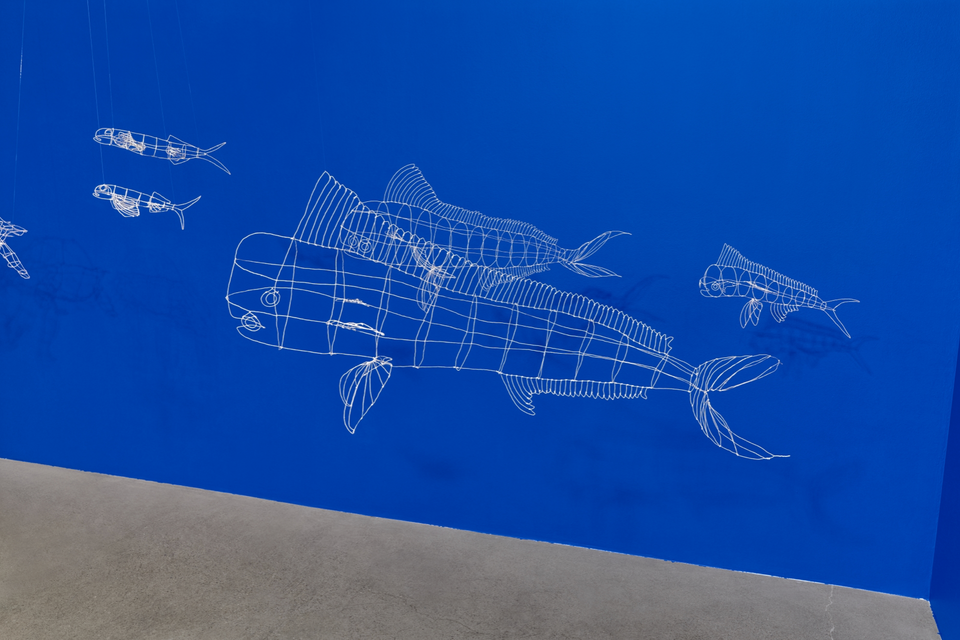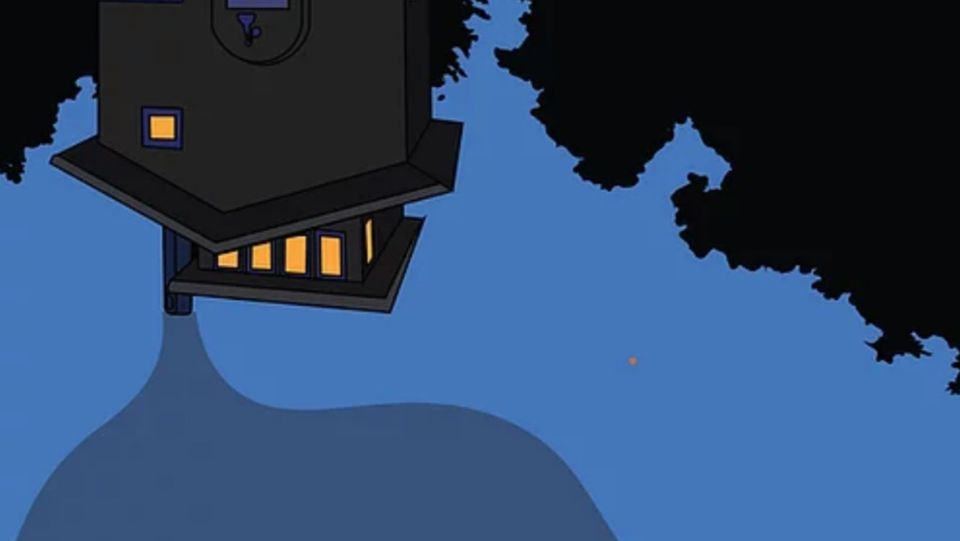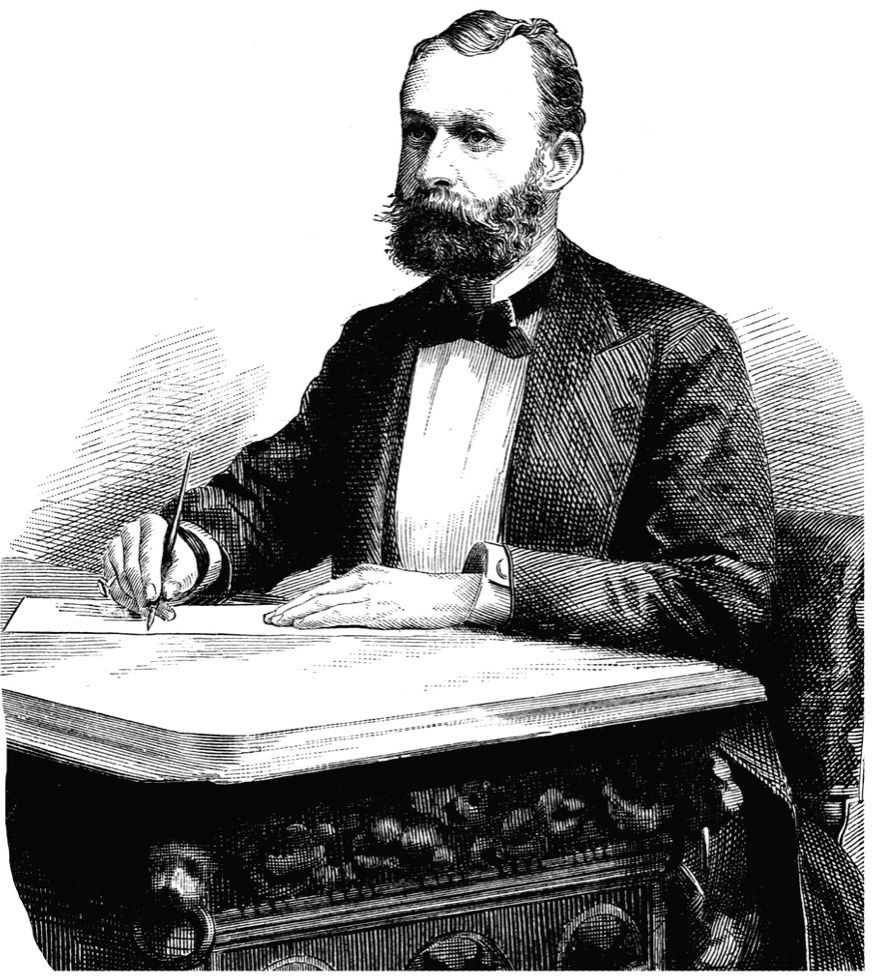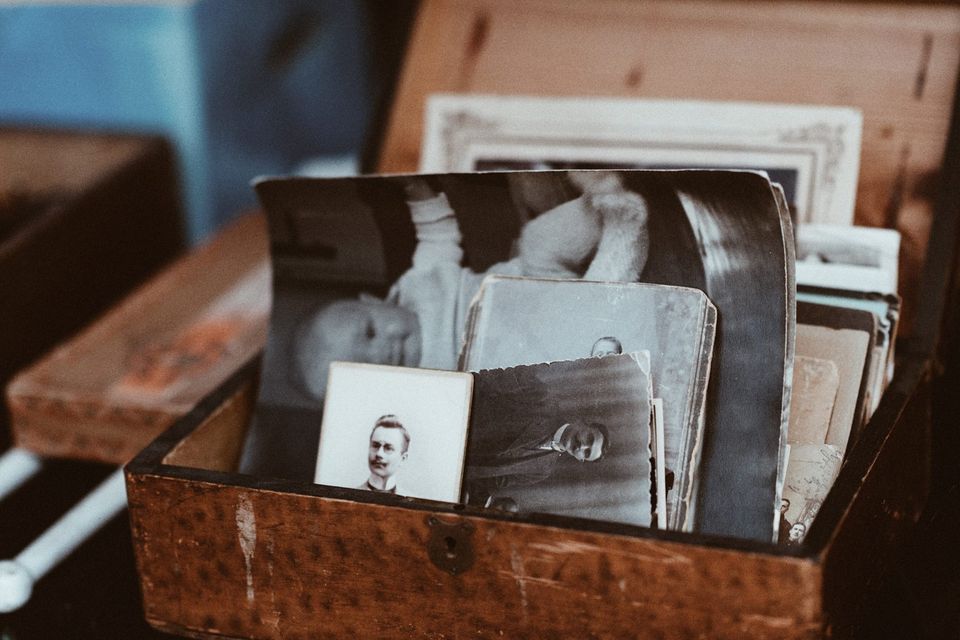When the words Waiting for the host to start this meeting appear on the TV screen, I call, “I figured out how to AirPlay the iPad to the Roku” to the kitchen, where Matt is washing the breakfast dishes. “It’s starting in two minutes!” It is a Saturday morning in January, and we are attending, on Zoom, Nina Katchadourian’s walkthrough of her new installation, To Feel Something That Was Not Of Our World, at the Catharine Clark Gallery in San Francisco.
The event opens with Orientation Video, which we’ve watched once before. A solid cloth background of steady blue, then Katchadourian’s mellow alto voice: “In 1975, when I was seven years old, my mother read a book out loud to me, a bestseller at the time: Survive the Savage Sea.” Her hands appear, sliding a worn copy of the book into the center of the blue rectangle.
In June 1972, the Robertson family of Staffordshire, England—father Dougal, mother Lyn, teenage son Douglas, 12-year-old twin boys Neil and Sandy—were over a year into a round-the-world sailing adventure when their small wooden schooner, Lucette, was smashed to bits by a pod of orcas near the Galápagos Islands. Floating in the Pacific, first in a rubber raft and then in a 10-foot dinghy, they survived by catching and eating sea turtles and fish, drinking the turtles’ blood, and slathering their skin with turtle oil to relieve painful saltwater boils. After 38 days, they were spotted and rescued by a Japanese tuna-fishing boat. Upon their return, Dougal wrote Survive the Savage Sea.
“I have been fixated on this story since childhood,” Katchadourian says. Against the blue rectangle, her hands move objects smoothly in and out of frame, like a magician doing a card trick. Family photographs of the Robertsons. A model of their dinghy, Ednamair. Copies of Survive the Savage Sea in Dutch, Danish, Czech. She flips open the French edition, Survivre à la mer cruelle, to show a diagram of how the seven adults and children (including a 22-year old Englishman named Robin Williams, a recent college graduate they had picked up in Panama) arranged their bodies to sit and sleep, first in the leaky raft, and then in the even smaller dinghy. Her hands stack worn copies of the book, then fan them out so the waves printed on the covers expand into an ocean. As she describes how a steamer passed by the floating family, failing to notice them, she sails a postcard of a ship magisterially from left to right, across the blue rectangle. As the last inch of the boat disappears, I feel a tiny throb of despair.
In spring 2020, COVID-19 began its spread across the world and Katchadourian’s decades-long obsession with the Robertsons’ ordeal entered a new phase. “We were all in the midst of our own individual and collective shipwreck,” Katchadourian says over Zoom, standing in the gallery alone and unmasked, as she explains how she gathered the courage to email 66-year-old Douglas Robertson, the eldest son, in May of 2020. Douglas, the author of a second book about the same events, became her willing informant and collaborator. From June 15 to July 22, 2020, Katchadourian revisited the family’s odyssey exactly 48 years later. Each day, the two spoke by telephone, reviewing the events of the same date in 1972, with Douglas sometimes correcting or expanding his father’s narrative. The show includes audio recordings from these conversations, photographs, and books, but the major pieces are images and artifacts crafted by Katchadourian: the last cup of coffee drunk before the Lucette was destroyed; painting after painting of ocean waves; life-size paper cutouts and wire sculptures of the sea creatures the family encountered; a video recreating the fresh fruit salad Douglas ate in a dream.
“A few days into our daily conversation, Douglas spontaneously began reading aloud to me,” says Katchadourian. “And so, forty-five years later, this story was read out loud to me again.”
Matt and I are at home in Los Angeles. It is 10 a.m, the Saturday morning cartoon hour of our childhoods. Our daughter is away at college, and we are sitting on the twin bed in her room, watching the TV we put there when she came home in the spring, when everything shut down. Now Katchadourian begins her solo walkthrough of the two rooms of the show. Her voice is calm, sincere, but her demeanor exudes the enthusiasm of a skilled teacher or a museum guide. Physically, we are inside the house where we’ve spent most of the past ten months, but we follow her like a tour group, lulled by a sense of inclusion, safety, the promise of seeing something wonderful.
*
To Feel Something That Was Not Of Our World, born alongside the COVID-19 pandemic, offers clear parallels to our shared voyage through it. Katchadourian writes of the completed show, “There is particular resonance to the subject of a shipwreck at the end of 2020, as so many have experienced isolation and uncertainty, unsure of what rescue and survival will require.” The Robertsons lived day to day and hour to hour, adjusting to shifting challenges, not knowing how long their ordeal would last or how it would end.
Imagination was crucial, not only to solve the problems of survival, but to maintain hope and cheer. They fantasized about opening a restaurant, populating the menu with the dishes they most longed for. Robin, their passenger, became their “radio,” extemporizing programs on demand, whether he knew anything about the subject or not. “Sing, sing to keep warm,” father Dougal ordered the family as they frantically bailed water at the height of a storm. And they never lost their capacity for awe: “Hell on earth, hell on earth,” muses son Douglas in the exhibit, “then the sun rises in the morning and the sea is quiet, and it’s nature’s beauty, and you can’t help but admire [it].” There is much to recognize for anyone who has sought distraction in a jigsaw puzzle during the past year, or who has felt moments of great anxiety and fear opening suddenly into moments of deep peace and gratitude.
At the heart of the exhibition, though, lies a child’s obsession with a story and the books that carry it. To Feel Something That Was Not Of Our World reflects the evolution of Katchadourian’s career-long—lifelong—fascinations with books, language, and family. One of the things that has drawn me to her work in the past is how wholehearted it seems in its approach to its subjects—a quality that has sometimes been called “playful” or “childlike,” but which, to me, seems to carry forward the authentic, unforced quality of childhood “special interests.” “I don’t actually believe that everything an artist makes is art. I think that’s bullshit; I’ve never believed it,” Katchadourian told Julianna Bjorksten in an interview in July 2020. “I think some things are made for the joy of making them, some things are made with a desire to start a dialogue about something, and sometimes things cross categories.“
Even more than Katchadourian’s other work, To Feel Something That Was Not Of Our World affirms the value of a child’s enthusiasm, both in its larger structure of retelling and replaying a familiar story and in each individual piece that makes up the show. The life-size watercolor cutouts of orca, sea turtle, and flying fish are pinned unassumingly on the gallery’s deep blue walls, like a grade-school class project on ocean life. Or, as my friend Lisa pointed out, like a rebus, a picture-story that helps children learn to read—a salvaged sail plus two dorado plus one bottle of turtle oil equals another day of survival.
You want to put your hand inside the wire sculptures of flying fish and thumb the books standing on a high shelf, their covers facing out, like books in an elementary-school library. And you certainly want to curl up in the life-size but impossibly small outline of the dinghy, painted on the floor—how ever did they all fit?
*
Think for a moment about the word project. We might use it to describe a billion-dollar urban development scheme that will transform a shopping district—then, without irony, use it to talk about our first-grader’s shoebox diorama. Artists have projects; so do gardeners, quilters, academics, activists. Projects are what we plan to do and what we have done when we are finished, whether in the classroom, the backyard, the office, or the studio. Katchadourian’s art often spans these spheres. For her 1998 project Mended Spiderwebs, she repaired broken spiderwebs with red sewing thread (efforts the spiders methodically rejected). In her 2014 short video Tree Shove, wearing a green padded coat and looking like an apprehensive Christmas tree, she is put through a netting machine, strapped to the roof of a car and driven off the lot to the festive strains of “O Christmas Tree.” One of her most widely-known works is the ongoing photography project Sorted Books, in which she sifts through the holdings of a particular private or library collection to create arrangements of book spines that spell out sentences or dialogues. When I look at them, I imagine the artist sitting on the floor, surrounded by multicolored stacks of books of all sizes, like a castle-building child who only reads the words on the bindings, leaving the words inside for later.
For Seat Assignment, another ongoing project, she challenges herself to make art on her frequent plane flights using only her phone camera and materials she finds at hand. In her series “Lavatory Self-Portraits in the Flemish Style,” she drapes herself in an airline blanket and a paper toilet seat cover and strikes poses startlingly reminiscent of 15th-century portraits. Her compositional skills and visual references are those of a mature artist, but she is also every child—every one of us—making confinement bearable by entertaining herself with available materials. The polysemic title of her 2017 career retrospective is Curiouser.
One piece in the current show connects to Katchadourian’s own family history, a history marked by displacement and immigration. For Lucy’s Sampler, Katchadourian reproduces samples of needlework created by her “bonus grandmother,” orphaned in the Armenian Genocide, who at 13 was taken in by Katchadourian’s paternal grandparents and whose “sewing, mending, ironing, knitting, crocheting, cooking, and cleaning” are recorded in an accompanying note. At first, this piece of handwork seems incongruous beside the coffee cup, bottle of turtle oil, and life-size paper orca. But the text makes clear that Katchadourian sees Lucy’s sampler as an emblem of her own family’s journey. She writes, “This was her CV, proof of a skill set that might make her useful in someone’s life and ensure her survival.” She learned to use an engraving tool in order to trace and reproduce Lucy’s stitches, as generations of children have learned to draw and write by tracing.
Katchadourian’s parents and brother appear in the show in a photograph of their family in various attitudes of climbing into or out of a small boat. Underneath, her mother has written in block capitals, “WHEN THE KATCHADOURIANS WERE RESCUED AT GUMBO, THE SEA WAS CALMED WITH TURTLE OIL.” It is mounted next to a book open to a picture of the Robertson family at the time of their rescue by the Japanese vessel Toka Maru II. The title of the paired photos: We Saw Ourselves In Your Rescue Photo.
As a child, you sail in the small boat of family across an ocean you don’t understand. Everything new—the endless variations of a wave, a flying fish—is a marvel, and you are hardly able to conceive of the shore. To grow up means not only “to write your own story”; it also means to revise the story you have lived so far. To reach the age of your own parents when you were born. To recognize that your “bonus grandmother” was also a refugee in peril, to see her labor and her skills that you have always taken for granted as necessary to her survival. Or, like Douglas Robertson, to look again at how your parents kept your family afloat when you were close to disaster.
One of Douglas’s memories of the rescue, on July 22, 1972, gives the show its title. In their conversation on July 22, 2020, he told Katchadourian that at first, he could not believe they were being rescued, even as the dinghy bobbed next to the Toka Maru II. Only when the fishing vessel let down a rope and he grabbed it did he believe it was real. “To feel something that was not us,” he told Katchadourian, “that was not of our world—that was so good.”
Katchadourian’s work is often described as “quirky,” but the essence of her art is an extraordinary steadiness and attention. It is not mere whimsy that makes someone construct tiny sections of spiderweb with tweezers and thread—or think about one book for 45 years. It is not whimsical when children reflect the small and large dramas of their worlds in their play, applying the same Band-Aid over and over to the same stuffed animal’s paw. And we rarely call children quirky when they are so deeply engaged in a drawing or a book or an arrangement of dollhouse furniture that they don’t hear us call them. We recognize that this absorption into another dimension of attention is part of the work of childhood. As we grow older, we call that realm the inner life. To Feel Something That Was Not Of Our World reveals that the child’s way of processing things is the human way. It builds resilience, connections, layers of meaning, webs of love. We should not seek to grow out of curiosity; we should seek to grow into it.
To Feel Something That Was Not Of Our World, Catharine Clark Gallery, San Francisco, CA, January 9-February 20, 2021; Columbus Museum of Art Pizzuti Collection, Columbus, OH, August 28, 2021-April 24, 2022; Pace Gallery, London, UK, summer 2022.




